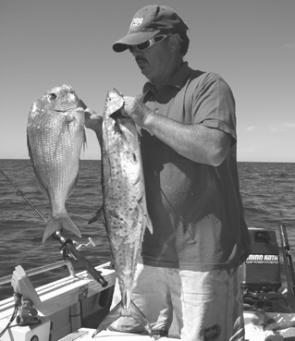Warm, tropical water is finally dominating the coast and now anything can happen, and I mean anything.
Billfish, mahi mahi, spotted and Spanish mackerel, cobia and longtail tuna prowl the ocean from the beaches to the continental shelf; sweetlip and the odd coral trout join the snapper, kings, trag and jewies over the reefs while mangrove jacks and trevally out-compete the flathead, bream, whiting and jew in the estuaries.
And whenever an onshore wind blows over that much warm water there’s also the strong chance of rain, and plenty of it, as only February on the NSW Northern Rivers can dish out. You have to go back only to February 2002 to see what flood rains can do to the river ecosystem, when around 20km of the river totally died of oxygen starvation after a flood.
The good days of February can be sensational, especially on the inshore reefs where variety truly is the spice of life for those anchoring and berleying.
Newly-arrived spotted mackerel round up the schools of slimies and the mackerel fleet usually loads up with livies first thing and then heads to the selected reefs such as Brunswick Heads’ Local reef, Lennox Pinnacle and Riordans Reef out of Ballina and Kahors and South reefs out of Evans Head.
There’s not a lot of imagination shown from most of the spotty exponents – they just follow the crowd to wherever word is the fish are biting and anchor as close as possible to the bloke already hooked up.
The predominant technique is to pin a live slimy a metre or two under a chunk of styrofoam and just wait it out. When the fish hits, the line cuts through the foam which drifts ashore to join the hundreds of other foam chunks that litter the beaches by season’s end some time in May.
NSW and international laws prohibit this type of pollution and it gives anglers a bad name. Balloons aren’t the answer, either. Once deflated, they present a big risk to sea birds, turtles and other creatures which find them and eat them only for the rubber to block their intestinal tracts.
Perhaps the best and cheapest solution is a running float of a couple of champagne corks or similar glued together and drilled to accept the line, with a stopper knot of heavier nylon or a match wedged into the hole. The fish don’t seem to strike much at the natural cork, which is used only to suspend the bait. The strike-indicating function of a float isn’t needed with these hard-hitting fish.
An alternative is one of those clear plastic bubble floats rigged on the line but the spotties don’t mind smacking those as they move rapidly through the water after a hooked fish.
Anyone floating lightly-weighted pilchard chunks further down the berley trail will also encounter some reasonable squire, visiting grassy, yellow and red-throated sweetlip and on the slightly deeper grounds trag, jew and even the odd coral trout.
Back on shore there should be a fair run of tailor murdering the bait schools around most headlands and beach gutters and a few bream and jewfish following up the mayhem. Whiting and dart will also be there for those who use beach worms or pipis.
Unless we get bulk rain the rivers should fish very well. Estuary water temps can approach 28° now – ideal for hungry mangrove jacks and marauding trevally, especially in the twilight of dawn and dusk and on into the night. Rock bars, bridges, rock walls, wharves and pontoons are all great feeding points for these predators.
Flathead are spread throughout the Richmond, Evans and Brunswick systems with the edges of most sandbars producing good fish on a falling tide. Whiting are also at their peak over the next month or so with plentiful catches on the deep running flats of the Richmond around Pimlico, where bloodworms and tube worms are essential baits. The bigger tides around the new and full moons seem to produce better catches.
The first heavy rains of the season should trigger the bream to start heading downstream from their near-freshwater Summer haunts. With river prawns and baitfish of all kinds abundant, this is a time of plenty in the estuaries. Many species are growing fat over the next couple of months before they think about their Autumn spawn runs.
Bass also are eating up big on all forms of insects, crustaceans and fish, with surface lures and flies working in the twilight and deeper spinnerbaits, crankbaits and plastics in the brighter parts of the day.
Reads: 2751
Inshore reefs can turn up mixed bags of snapper, mackerel and other tropical visitors this month.

Bass such as this 48cm popper-gulper will be lure candidates for as long as the rivers run relatively clean.




